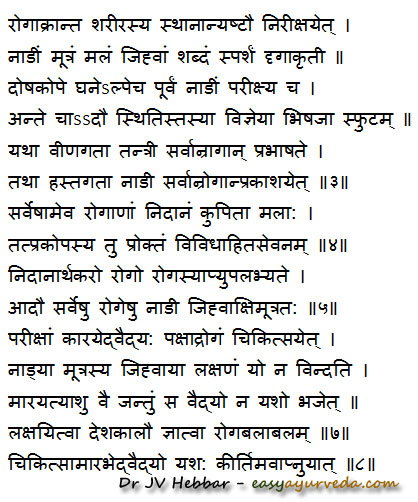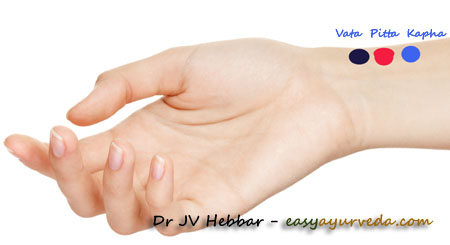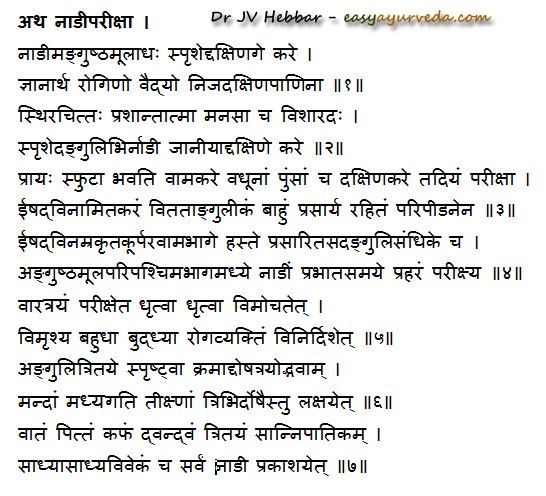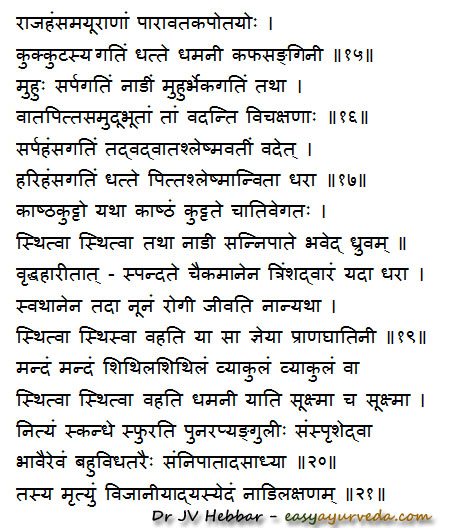Pulse diagnosis has a very limited but important role in Ayurvedic diagnosis methods. The pulse reading technique was non existent in ancient periods of Charaka Sushruta and Vagbhata. They have not mentioned about this technique. Only in the seventeenth century, Yogaratnakara book mentions the pulse examination technique in detail. Let us explore.
Before that, for a clear understanding of limitations of pulse diagnosis technique, please read below article –
Why Charaka and Sushruta did not mention about pulse diagnosis?

In a patient, eight places should be examined.
1. Nadi – Pulse
2. Mutra – urine
3. Mala – feces
4. Jihva – tongue
5. Shabda – the various body sounds (such as crackling in case of arthritis), voice hoarseness etc.
6. Sparsha – examination by touch. – to know body temperature, local raise of temperature in a swelling etc.
7. Druk – external appearance of the person, examination by eyes.
8. Akruti – shape and built of the person.
Doctor should examine the pulse in the initial consultation to know about the extent of Dosha imbalance. After the treatment, at the end of disease also, doctor should do pulse examination to know the difference.
Like the strings of Veena generates all Ragas, similarly the pulse of the hand enlightens all the diseases.
The root cause for all diseases is imbalance of Tridosha (Vata, Pitta and Kapha) and cause for Tridosha imbalance is improper food and activities. As the time goes by, one disease itself may become the cause for another disease.

Before starting treatment, doctor should examine pulse, tongue, eyes and urine. That doctor who does not know about the signs and symptoms to observe in pulse, tongue and urine, will kill the patient and such a doctor can never be successful.
Doctor should take, place (place of person and site of disease affliction in the body) and time into consideration (season, chronicity of the disease etc) to judge the strength of the disease. Such a doctor who does that before starting treatment will get success and fame.

Table of Contents
Nadi Pareeksha – Pulse Diagnosis
For the purpose of knowing the disease, the doctor with his right hand should examine the pulse of the right hand of the patient at the root of the palm. With a stable and calm and concentrated mind, the doctor should feel pulse with his finger tips.
The hand to examine pulse
In female, probably the left hand gives accurate pulse reading and in men, the right hand. Hence, pulse of left hand should be examined for women and right hand for men.
Method of starting pulse reading
The arm of the patient should be extended, hand of the patient should be slightly bent at the elbow joint, the fingers should remain straight. The patient should not feel any pain or discomfort. The pulse examination should be done at the root of the fingers, in the wrist part, in the first three hours (Prahara) of the morning. (3-4)
The pulse should be examined three times, by feeling the pulse and giving gap in between. With due intelligent analysis, the disease should be diagnosed. The doctor should use his three fingers to know about the status of Vata, Pitta and Kapha respectively. The doctor should observe the
Mandagati – mind movement of pulse
Madhya gati – moderate movement of pulse and
Teekshna gati – sharp, swift movement of pulse. (6)
With pulse diagnosis, the doctor can know about imbalance of individual Doshas – Vata, Pitta Kapha, imbalance of two of these Doshas together or imbalance of all the three Doshas together.

Synonyms of Pulse
Snayu, Nadi, Hamsi, Dhamani, Dharani, Dhara, Tantuki, Jeevana Jnana.
Contraindications
Contra indication for pulse reading:
Those who have just taken bath, who have just taken food, those who have just undergone snehana (oil massage or fat intake), who are having thirst and hunger and who are asleep – in these, the pulse cannot be well appreciated.
The pulse that can be felt at the root of the thumb indicates about disease and health.
In women, left hand or left leg should be examined for pulse.
Examination of Nadi should be done as thoroughly as examination of gems.
Dosha Nadi – Dosha pulse
Lord Brahma lies in Vata Nadi
Lord Shankara lies in Pitta Nadi
Lord VIshnu lies in Kapha Nadi.
At the distal part, flows the Vata Nadi, in the middle, flows Pitta nadi and in the proximal part flows the Kapha nadi.
Vata pulse feels as if movement of snake and leach.
Pitta pulse feels as if movement of Kaka (crow), Lavaka (common quail) and frog.
Kapha pulse feels as Rajahamsa (swan), Paravata (pigeon), Kapota (dove), Kukkuta (cock).

In Vata-Pitta imbalance, snake kind of pulse and frog kind mixed.
In Vata-Kapha imbalance, snake and swan kind of pulse.
In Pitta – Kapha imbalance, Hari (monkey) and Hamsa (swan) kind of movement in pulse.
In case of Sannipata – imbalance of all the Doshas together, then like woodpecker (Kashtakutta), the pulse will felt swiftly sometimes with frequent gaps.
Pulse to identify incurable diseases
Pulse reading indicating incurable disease – Asadhya Nadi –
The pulse which beats for 30 times speedily and then subsides abruptly, and that pulse which runs with lot of interruption.
The pulse which is weak, mild, feeble, stops in between, very minute, which is sometimes felt feebly in shoulder and sometimes at wrist, such a Nadi indicates an incurable disease.
When the Nadi is like Damaru (musical instrument of Lord Shiva), sometimes observable, sometimes not, it indicates incurable disease.
The pulse which is too high, too frequent and fast, suggests death in future. The Nadi which is stable but suddenly sparks up like a lightening, suggests incurable disease.
The feeble and cold Nadi suggests death is certain within a day or two.
If the feature of the Nadi changes from Vata to Pitta and to Kapha, which keeps on circulating in this manner, which suddenly rises and falls on its own, such a Nadi reading indicates incurable disease.
The Nadi which is swift, felt only near to the distal one third of wrist, often feels cold, associated with sweating, suggests death within a week.
Person with cold body, who suffers from dyspnoea, breathes forcefully with mouth, with swift Nadi dies within 15 days.
In the pulse place, if the distal part does not read any pulse, middle part is cold and proximal part is feeble, the person dies within 3 days.
Similar to these, a few more Nadi symptoms suggesting death are mentioned in this chapter.
If the Nadi becomes steep (Gambheera), then it indicates that it runs in Mamsa Dhatu (Muscle tissue) – Mamsavahini.
It the pulse reading feels hot, it implies fever.
Due to Kama (sexual desire) and anger, the pulse rate increases. Due to worries and fear, low digestion strength and depleted body tissues (Ksheena Dhatu), it decreases.
When blood (Rakta Dhatu) is dominant and when Ama is there (altered digestion and metabolism), then it will be bulky, heavy and hot. When the digestion strength is more, Nadi will be light, and fast.
In hungry and satiated person (who has taken food), the pulse will be stable.
In case Nadi is not felt in hand, it should be examined in leg.
In case of Vataja Jwara (fever of Vata origin), Vakra – Nadi will be zig zag, swift, and cold to touch.
In sheetapitta Jwara (fever due to allergy), Nadi is fast, and thin.
In Jwara due to Kapha, the Nadi is mild, stable, cold and sticky. Similarly, Nadi features of fever with duel Doshas are mentioned.
Overall, the Nadi examination is explained with the intention of
– identifying the Doshas involved in the disease
– identify extent of Dosha involvement
– to know the in curability of the disease.










11 comments
sulabha
Nice. Quite informative.
Subhassh c Kurup
Wonderful.To the point and informative
narayanasamy annamalai
it’s just like alopathy medicine,for example rythm (irregularly regular,(irregularly irregularatrial fibrilation….,)tachycardia,arrythmia.good information.tq
Janardhan Shelke
Thank you so much sir..Please suggest any referal books if any I want to know much more.
Rahul
Dr J V Hebbar, your website information is truly very helpful and you are doing great work. 🙂 These days, it is very difficult to find good nadi vaids. Can you please tell me 2-3 good nadi vaids in india with contact information. Thanks in advance for your reply.
Dr J V Hebbar MD(Ayu)Author
I do not know personally, anyone. Any good Ayurveda doctor with good reputation is a good fit for consultation.
B.J.Trivedi.
In a horoscope, Nadi is also mentioned out of three Nadis. Aadhya means VAAT, Madhya means PITTA & Antya means KAPHA. Is this true? If it is, does it indicate constitution / Prakriti of the person?
preeti
thank you very much sir, it’s easily understan n informative
furkan malik
vaidya furkan malik in muradnagar ghaziabad
navneet mathur
Please Tell me nadi vaidya in jaipur
Dr J V Hebbar MD(Ayu)Author
Please consult at National Institute of Ayurved.